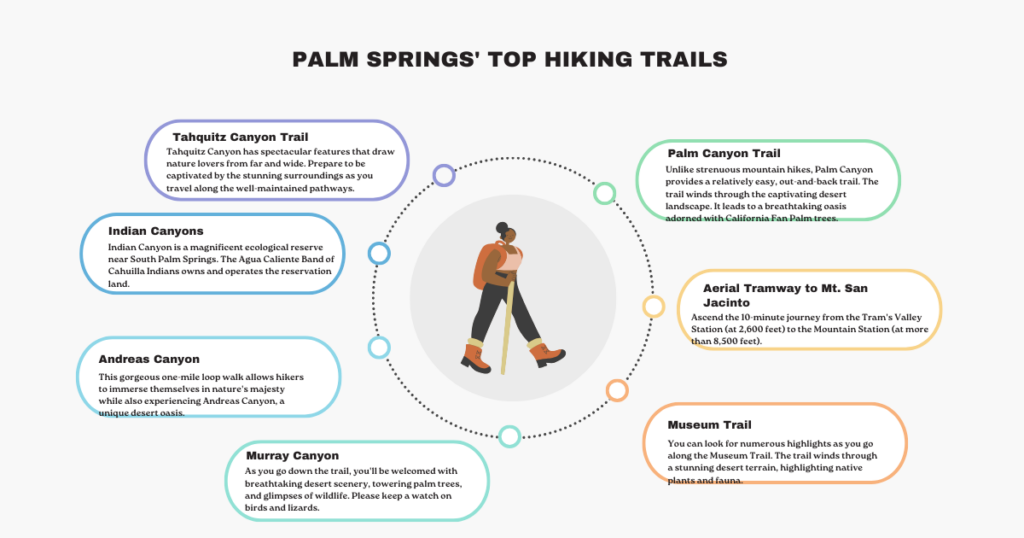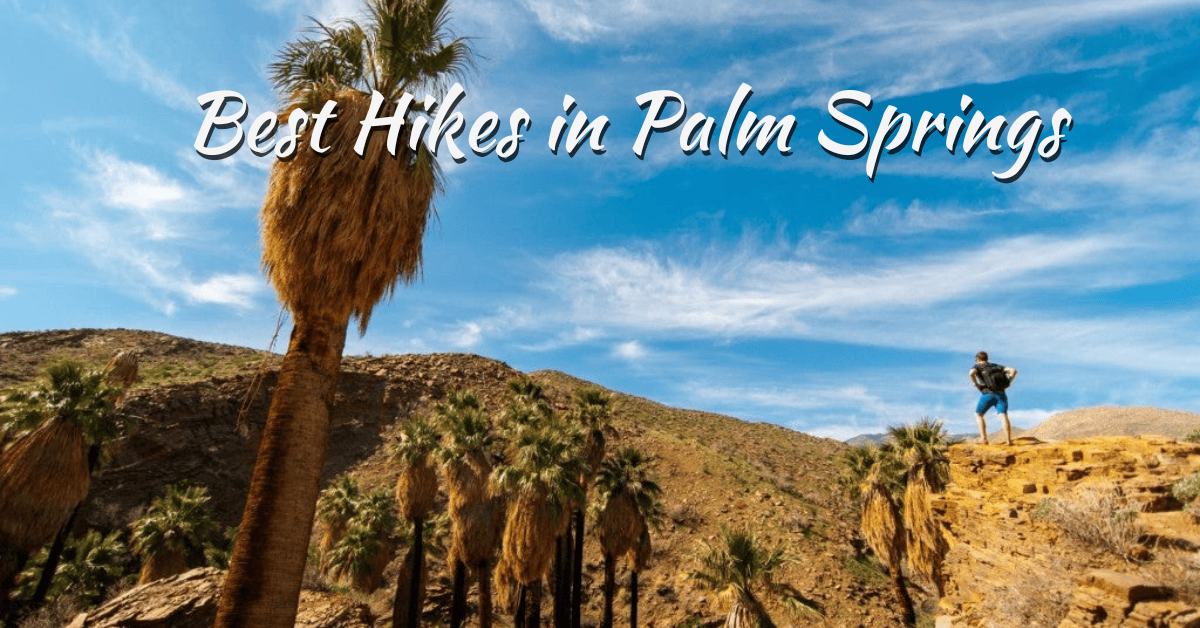Greater Palm Springs’ rich natural beauty offers numerous opportunities for exploration, making it a haven for outdoor enthusiasts seeking the best hikes in Palm Springs.
Some people go on adventures in jeeps, some in hot air balloons, and some prefer horses or bicycles. Some people prefer trekking.
Greater Palm Springs has over 100 paths to select from.
Hiking, done step by step on your own two feet, combines exercise with up-close exploration of the oasis’s most attractive locations. Find several lovely hikes to try below.
Explore Palm Springs’ Top Hiking Trails
Here is a detailed description of popular hikes, such as the Palm Springs Aerial Tramway to Mt. San Jacinto, Indian Canyons, and Tahquitz Canyon, focusing on distance, difficulty, and scenic features.

- Tahquitz Canyon Trail: Easy Hike to Stunning Waterfalls
Tahquitz Canyon has spectacular features that draw nature lovers from far and wide. Prepare to be captivated by the stunning surroundings as you travel along the well-maintained pathways.
- Towering palm trees, luxuriant flora, and dramatic rock formations create an unearthly atmosphere.
- The canyon’s highlight is the stunning 60-foot-tall Tahquitz Falls, where a seasonal waterfall pours down a granite cliff, creating a refreshing respite in the desert landscape.
| Difficulty | Easy |
| Distance | 2-mile loop |
| Elevation Gain | 324 feet |
| Dogs Allowed | No |
| Kid Friendly | Yes |
- Indian Canyons: A Desert Oasis Adventure
Indian Canyon is a magnificent ecological reserve near South Palm Springs. The Agua Caliente Band of Cahuilla Indians owns and operates the reservation land.
The park covers 31,500 acres and is home to stunning canyons, distinctive rock formations, and lush flora.
Indian Canyons has various hiking paths, including Andreas Canyon, Murray Canyon, and Palm Canyon. Each hike provides a unique experience with breathtaking views of the canyons and surrounding countryside.
It is a beautiful and significant environmental reserve that provides visitors with a unique insight into the history and culture of the Agua Caliente Band of Cahuilla Indians. It has almost 60 km of hiking paths.
Andreas Canyon
This gorgeous one-mile loop walk allows hikers to immerse themselves in nature’s majesty while also experiencing Andreas Canyon, a unique desert oasis.
- This trail is ideal for hikers of all skill levels, whether they are experienced or new to the outdoors.
- The path begins at Andreas Canyon Parking Lot, which offers plenty of parking and restrooms. Please bring a hat, sunscreen, and appropriate desert trekking gear.
| Difficulty | Easy |
| Distance | 1-mile loop |
| Elevation Gain | 177 feet |
| Dogs Allowed | No |
| Kid Friendly | Yes |
Murray Canyon
As you go down the trail, you’ll be welcomed with breathtaking desert scenery, towering palm trees, and glimpses of wildlife. Please keep a watch on birds and lizards.
- After around 2 kilometers of climbing, you’ll reach the hike’s highlight: Seven Falls.
- This succession of cascading waterfalls is a true natural wonder and a welcome refuge in the desert.
- Take some time to unwind and enjoy the beauty of the falls. You can also take a plunge in one of the pools.
| Difficulty | Moderate |
| Distance | 3.7-mile loop |
| Elevation Gain | 538 feet |
| Dogs Allowed | No |
| Kid Friendly | Yes |
3. Palm Canyon Trail: A Quick Escape into Nature
Unlike strenuous mountain hikes, Palm Canyon provides a relatively easy, out-and-back trail. The trail winds through the captivating desert landscape. It leads to a breathtaking oasis adorned with California Fan Palm trees.
- The Palm Canyon Trail is a breeze compared to challenging hikes. It’s a moderate 2-mile round trip, making it achievable for most visitors.
- The trail leads to a stunning palm grove, a surprising sight in the arid desert. The contrast between the palms and the rugged canyons creates a memorable landscape.
| Difficulty | Easy |
| Distance | 2-mile loop |
| Elevation Gain | 210 feet |
| Dogs Allowed | No |
| Kid Friendly | Yes |
4. Aerial Tramway to Mt. San Jacinto: For the Adventurous
Ascend the 10-minute journey from the Tram’s Valley Station (at 2,600 feet) to the Mountain Station (at more than 8,500 feet).
- Mount San Jacinto State Park has 54 miles of trails, ranging from picturesque treks to strenuous challenges.
- For a happy balance, take the 2.5-mile stroll to the lovely Round Valley.
| Difficulty | Hard |
| Distance | 10-miles loop |
| Elevation Gain | 2578 feet |
| Dogs Allowed | No |
| Kid Friendly | No |
5. Museum Trail: A Challenging Path with Incredible Views
You can look for numerous highlights as you go along the Museum Trail. The trail winds through a stunning desert terrain, highlighting native plants and fauna.
- You’ll also see interpretive signs that provide intriguing information about the surrounding habitat and wildlife. The trail mainly travels straight up the mountain’s spine to picnic benches and vista areas.
- One of the trail’s attractions is the Vista Point, which is located around halfway through the hike.
- This magnificent overlook provides a panoramic view of the Coachella Valley, Palm Springs, and the surrounding mountains.
| Difficulty | Hard |
| Distance | 1.6-miles loop |
| Elevation Gain | 833 feet |
| Dogs Allowed | No |
| Kid Friendly | No |
Wildlife and Flora Along the Best Hikes in Palm Springs
Palm Springs’ diversified habitats enable unique vegetation and wildlife across various elevations:
Each path offers a distinct view on the desert’s vegetation and animals, making Palm Springs an ideal hiking destination for nature enthusiasts.
Flora
Joshua trees, ocotillo, and agave are among the characteristic desert species found at lower elevations. The oases, such as those in Indian Canyons, support fan palms and cottonwood trees, resulting in lush, calm getaways.
Wildlife
Native wildlife includes bighorn sheep, desert tortoises, jackrabbits, and roadrunners. Common birds include red-tailed hawks, California quails, and Costa’s hummingbirds. Sidewinder rattlesnakes and desert iguanas thrive in this arid environment.
Tips for Safe and Enjoyable Hiking in Palm Springs
Ten necessities for hiking in this sanctuary in Southern California are as follows:
Water
2 liters minimum – depending on the temperature and intensity, anticipate a half to a full liter of water each hour.
Nutrition/Snacks
Consider trail mix and granola bars; protein is crucial for maintaining energy levels and aiding in post-hike recovery.
Map & Compass
Download the trail map straight to your smartphone since you might not always have cell coverage.
Use Sunscreen
With over 300 days of sunshine annually, you’ll need both a hat and sunscreen. The American Academy of Dermatology recommends using sunscreens with at least 30 SPF.
Additional Layers
Sun protection is offered by long sleeves and trousers. Wearing long, light layers is the greatest way to stay cool and shield your body from the sun throughout the summer.
A First Aid Kit
Unpredictability is a feature of nature. Keep the essentials on hand, including tweezers, aspirin, insect sting spray, bandages, antiseptic wipes, antibacterial ointment, and Benadryl for allergic reactions.
Comb
To get rid of prickly stems and possible cactus spines
Flashlight, hand mirror, and whistle
For individuals who enjoy watching sunsets, a flashlight
If your cell doesn’t work, use your hand mirror to signal for assistance.
In the event that you are separated from your group, whistle
Accessibility on the Best Hikes in Palm Springs
The Indian Canyons trailheads allow hikers to fully experience Greater Palm Springs’ natural environment.
- Numerous hiking trails with differing levels of difficulty are available. The Murray Canyon and Andreas Canyon Trailheads in the Indian Canyons offer specialized wheelchair accessible paths.
- The other paths are far less demanding and have lovely palm groves, picnic tables, and a tranquil creek that runs directly through the trail, even though they may be less developed and made of dirt rather than gravel.
- This guarantees that the majority of guests will be able to pass through with ease and have a picnic beneath the palm trees.
Safety Guidelines for Hiking the Best Trails in Palm Springs
Hiking in Palm Springs necessitates planning to ensure comfort and safety. Here are a few crucial tips:

Drink plenty of water and hydrate!
When half of your water is gone, it is time to turn back. It may seem obvious to drink enough of water, yet most hikers overlook the significance of hydrating their bodies the night before embarking on a trek.
Alcohol is also not suggested because it promotes dehydration. Carrying as much drinking water as possible is a priority.
Hikers should carry at least one quart of water for every hour they hike. It is too late to drink just when you are thirsty.
Avoid the Heat
It’s best to get up before nine in the morning. Steer clear of hiking during the hottest parts of the summer. Summertime may not be the ideal season for hiking due to the high heat.
Heat exhaustion or heat stroke can occur when you push your body against the heat. Before you leave, be ready and aware of the warning signs.
Power in Numbers
Never trek by yourself and always let someone know where you’re going. Even the most seasoned hikers encounter circumstances that could have hazardous outcomes.
A hiking companion can go for assistance if you get hurt and are unable to continue traveling.
Stay on the Trail
Continue on the trail. It can help protect the natural environment and keep you from getting lost. In Greater Palm Springs, hikers must always stay in designated, open spaces.
Usually, these places are watched over to make sure the pathways are clearly marked and secure.
Wear appropriate clothing for the event
It’s crucial to wear supportive and traction-enhancing footwear. Hikers who wear sandals, flip-flops, or other footwear with a slick sole run the risk of falling and suffering severe injuries.
Another way to protect yourself from the sun and the weather on trails is to wear long-sleeved clothes and pants. Sunglasses, a wide-brimmed hat, and loose clothing will also be beneficial.
Be mindful of the animals
For everyone’s safety, give wildlife space. Numerous desert creatures, including coyotes, mountain lions, snakes, and big-horned sheep, can be found in Greater Palm Springs.
Consider all snakes to be harmful, and be mindful of your footing and hand placement. If you come across a snake, give it space. Avoid handling or hurting snakes.
Technology Isn’t Always Beneficial
Don’t rely on your mobile device. Charge before you travel, however be aware that there may not be as much service on the trails.
A first aid box, flashlight, GPS, map, whistle, poncho, and pocket knife are additional practical items that can be helpful.
Conclusion | Best Hikes in Palm Springs
Hiking in Palm Springs offers the chance to see a variety of distinctive landscapes, such as desert oases and steep cliffs.
Outdoor enthusiasts will find nirvana in the region, which boasts well-maintained routes, a variety of difficulty levels, and uncommon ecological beauties.
Palm Springs provides a restorative getaway into nature, regardless of your level of hiking experience.
With expansive vistas and the tranquil sound of a waterfall in the middle of the desert, Palm Springs’ paths provide both difficulty and beauty.
You may safely explore the region, enjoy its thriving ecosystem, and get the most out of every trekking experience with the help of this guide.
Enjoy your time on the trails and bring home priceless memories of the breathtaking Palm Springs scenery in addition to pictures.
Best Hikes in Palm Springs FAQs
1. What are the best hiking trails in Palm Springs?
Some of the best hiking trails in Palm Springs include Tahquitz Canyon, Indian Canyons (including Andreas Canyon, Murray Canyon, and Palm Canyon), Aerial Tramway to Mt. San Jacinto, and Museum Trail. These offer a variety of landscapes from desert oases to panoramic mountain views.
2. Are there any easy hikes in Palm Springs?
Yes! Tahquitz Canyon and Palm Canyon both feature easy hikes suitable for beginners. These trails offer beautiful desert scenery, including palm groves and waterfalls, with manageable distances and gentle elevation gains.
3. Can I bring my dog on the hikes in Palm Springs?
Unfortunately, dogs are not allowed on most hiking trails in Palm Springs, including Indian Canyons, Palm Canyon, and Aerial Tramway. However, always check specific trail regulations before your hike.
4. How difficult are the hikes in Palm Springs?
The hikes vary in difficulty:
- Tahquitz Canyon (Easy) – 2-mile loop
- Indian Canyons (Easy to Moderate) – Trails ranging from 1 to 3.7 miles
- Aerial Tramway to Mt. San Jacinto (Hard) – 10-mile loop
- Museum Trail (Hard) – 1.6-mile loop with 833 feet of elevation gain
5. Are there any wheelchair-accessible hiking trails in Palm Springs?
Yes, the Murray Canyon and Andreas Canyon trailheads in Indian Canyons have specialized wheelchair-accessible paths. Other trails may have less developed paths, but some offer scenic spots with picnic tables and tranquil creeks.
6. What should I bring for a hike in Palm Springs?
For a safe and enjoyable hike, it’s recommended to bring:
- At least 2 liters of water
- Sunscreen, hat, and protective clothing
- Snacks like trail mix or granola bars
- A first aid kit, map, and compass
- Flashlight and whistle
7. When is the best time to hike in Palm Springs?
The best time to hike in Palm Springs is early in the morning, especially during the hotter months. Avoid hiking during the midday heat. The cooler months, from fall to spring, are ideal for outdoor activities.
8. Is there wildlife on the trails in Palm Springs?
Yes, Palm Springs is home to diverse wildlife, including bighorn sheep, desert tortoises, coyotes, and various bird species. Always be mindful of wildlife, and give them plenty of space.
9. Can kids enjoy hiking in Palm Springs?
Many of the hikes in Palm Springs are kid-friendly, such as Tahquitz Canyon, Andreas Canyon, and Palm Canyon. These offer shorter, manageable trails with scenic rewards, making them great options for families with children.
10. Do I need to have experience to hike in Palm Springs?
No prior experience is necessary for many of the trails in Palm Springs, as there are hikes suitable for all levels of fitness and experience. However, always make sure to choose a trail that matches your comfort level and bring the right gear for safety.





